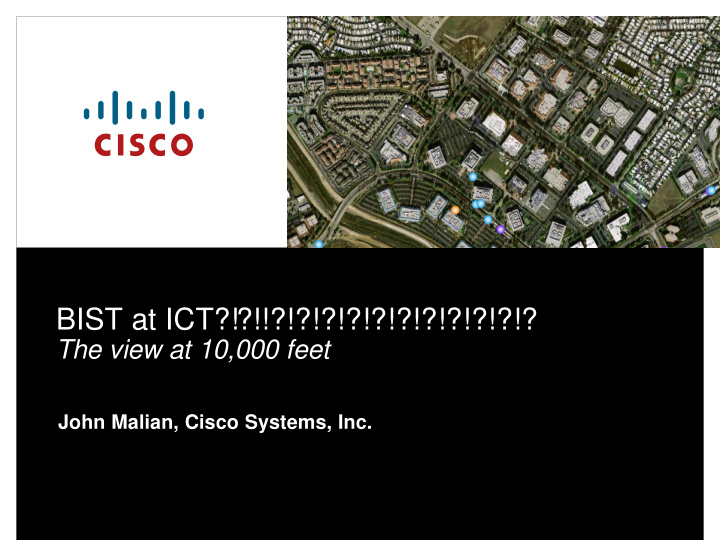



BIST at ICT?! ?!!?!?!?!?!?!?!?!?!?!?!? The view at 10,000 feet John Malian, Cisco Systems, Inc.
Agenda � Background � Benefits � Current Method � Deployed Projects � Challenges � Future Considerations
Background � There is a growing need for internal test structures inside our ASICs Content addressable memory (CAM) for example, may require a “brute force” method of testing all cells, which may take hours in a CPU access test. BIST reduces test time to seconds � BIST via JTAG available on many Cisco ASICs Number of devices increasing � Need a correlation between chip level testing and system level testing
Background - Key Members ASIC Test Structural Test ASIC DFT • Kevin Nguyen • Jaclyn Dang • Eo Trinh • Han Ta • Steve Lee • Trung Pham • John Malian • Matthias Kamm • Lap Le • Zoe Conroy • Bill Eklow We still have a lot of work to do, but without their expertise we would have not gotten this far
Benefits � Running BIST at In-Circuit Test allows for easier ASIC replacement of bad components System is not fully assembled (heat sinks, chassis, trays) Possible need for external thermal management � Added level of coverage before functional test Capability of testing portions of ASIC cores At-speed testing of key IO signals and memory busses � Possible benefits Power/GND coverage – not direct failure, but assumed
Current Development Flow Convert Set Up Debug and Generate Debug and Deploy to Observe SVF to Macros Verify SVF Verify CM Results PCF Asset Scanworks In-Circuit Test System Note: Biased to Asset and Agilent
Current Method – Manufacturing Flow Previous Test Processes In-Circuit Functional PASS Test with Test BIST F A I L Repair or ASSET Replace Debug
Deployed Projects � Paradise – MBIST, PRBS* internal/external 1G/2G/4G � Uros – MBIST, DC LBIST, AC LBIST, PRBS internal and external 2G/4G � Luke – AC LBIST � Pixar – LBIST, MBIST *PRBS: Pseudorandom Binary Sequence
Deployed Projects - Paradise SFP Loopbacks
Deployed Projects – Uros Thermal Management SFP Loopbacks
Challenges � Is the test really working? � Diagnosis capability � JTAG vs. Functional Access � Voltage and/or Temperature variance? � Thermal management � How to control noise in the fixture? � Do we have enough juice? � Timing
Challenges: Is the Test Really Working? � Challenges Traditional ICT relies on fault insertion for test effectiveness Getting a BIST test to pass has a “false” sense of security Most BIST tests are internal only � Possible Solution Use a socketed board and known bad parts from vendor Make sure bad parts failed at nominal temperature/speed
Challenges: Diagnosis � SVF patterns do not carry diagnostic information Internal BIST tests at in-circuit test can utilize a go/no-go test as the only method of repair is ASIC replacement � External BIST tests have more challenges: How to pinpoint a defect at the pin level?
Challenges: JTAG vs. Functional Access � Confusion over test passing in-circuit test and failing functional � Need to make sure that BIST tests executed at the functional level (i.e. PCI access, for example) match with 1149.1 accessible BIST tests. If not possible – then document these limitations
Challenges: Temperature/Voltage Variations � Example: ATE Part is tested on 93k at 7% voltage/temperature margin In-Circuit Test Temp control at in-circuit test very difficult to impossible Voltage trim depends on board design – some products at 3% Functional Test Temperature control in a chamber Voltage trim still dependent on board design
Challenges: Thermal Management Blocks with Thermal interface pads
Challenges: Thermal Management back front
Challenges: Noise Inside the Test Fixture � In-circuit test fixtures are noisy! Adequate for the most part on static-state signals, but might not be adequate for high-speed switching � Dual-stage fixturing has helped in alleviating all seen issues Only probe necessary signals for BIST tests Power/GND, JTAG TAP, discharge � Wireless fixtures might mitigate some issues related to crosstalk Still have to contend with a noisy testhead
Challenges: Current Considerations � Concerns over current requirements on BIST tests � We have not seen an issue so far Does not mean it will not be an issue � Clean power delivery is important
Challenges: Timing � Some BIST tests will require external clocks – on board or off-board External modules might be required � Some BIST tests are dependent on TCK speeds
Future Considerations � Standardization of programming language? Maybe some sort of high level macro language? � Any other methods of generating vectors? WGL to PCF? Diagnosis Capability
Q and A
Recommend
More recommend